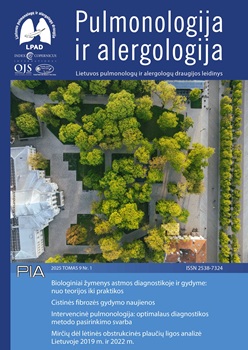ANALYSIS OF THE DEMOGRAPHIC AND CLINICAL DATA OF PATIENTS HOSPITALIZED AND TREATED FOR PNEUMONIA AT THE PULMONOLOGY DEPARTMENT OF THE HOSPITAL OF LITHUANIAN UNIVERSITY OF HEALTH SCIENCES KAUNO KLINIKOS IN 2023–2024
Abstract
Pneumonia is one of the most common causes of hospitalisation worldwide, with high morbidity, mortality, and economic burden on health systems. In clinical practice, it is important to understand its epidemiological and clinical features in different healthcare settings. Aim of the study. To retrospectively evaluate the cases of patients with pneumonia treated at the Hospital of Lithuania University of Health Science Kauno klinikos (Kauno klinikos) Department of Pulmonology between 2023 and 2024. Methods. The study was a retrospective analysis of the medical records of adult patients diagnosed with pneumonia according to the International Statistical Classification of Diseases and Related Health Problems, tenth revision, 10th revised and supplemented, Australian modification (ICD-10-AM) codes J12-J18, treated at the HLUHS KK Department of Pulmonology between 2023 and 2024. A total of 464 patients were included. Demographic, clinical, laboratory, microbiological examination, disease and treatment history, comorbidities, complications, and outcome data were collected. Results. The study analysed data from 464 patients treated for pneumonia between 2023 and 2024. The majority were men (67.5%), with the most common age group being 36–64 years. The most common symptoms were fever (65.7%), cough (55.0%), and dyspnoea (48.8%). Laboratory markers of inflammation (C-reactive protein, leucocytes, procalcitonin) were significantly higher in patients who required intensive care. Most often, not all of these indicators were assessed for each patient. The causative agent of pneumonia was adjusted in 221 patients and identified in 42.5% of cases. The most common pathogens were Pseudomonas aeruginosa, Klebsiella pneumoniae, Candida albicans, Mycoplasma pneumoniae. Some of these pathogens showed resistance to commonly used antibiotics. Empirical treatment was usually started with cefuroxime or ampicillin/sulbactam. More than half of the patients (59.6%) required treatment adjustments during treatment. The frequency of treatment changes correlated with age and microbiological testing. The average number of comorbidities per patient was 2.6, with arterial hypertension being the most common. Acute respiratory failure was the most common complication. The average length of hospitalisation was 12.4 days. The majority of patients (94.6%) recovered or had unresolved outcomes. The estimated mortality from pneumonia was – 5.4%. Conclusions. The clinical course, aetiology and treatment tactics of pneumonias in the HLUHS KK Department of Pulmonology had clear similarities with the trends described in other countries, but some differences were also evident, such as an atypical spectrum of the most frequently detected pathogens, a more frequent adjustment of antibiotic therapy, a longer length of hospital stay, and a relatively low mortality.


